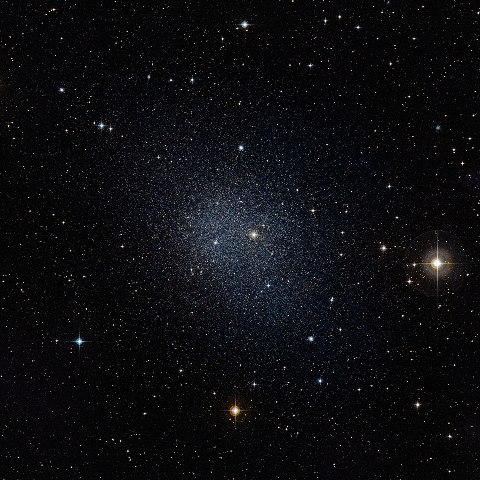
The
Fornax dwarf galaxy.
Credit: ESO/Digitized Sky Survey 2
Primitive Stars and Galactic
Eggs
Aug
26, 2010
A
new method of comparing stellar
spectra with computer models enables
astronomers to distinguish primitive
stars—ones that formed shortly after
the Big Bang—from younger stars with
similar compositions. In the
Electric Universe, the distinction
is irrelevant.In the Gravity Universe, primitive clouds of hydrogen collapse under their own
gravity into stars. Thermonuclear reactions in the cores of the stars cook the
hydrogen into heavier elements. The stars explode and fling the heavier elements
into space, seeding nearby hydrogen clouds with the heavier elements. When those
clouds collapse, their stars will show increased amounts of heavier elements in
their spectra—what astronomers call metallicity.
Primitive aggregations of primitive stars (generally dwarf galaxies) merge into
larger galaxies. Spiral arms develop from gas clouds seeded by supernovae in the
dwarfs, producing the two populations of stars: redder lower-metallicity
Population II stars in the galactic centers and bluer higher-metallicity
Population I stars in the arms. Roughly and generally speaking, metallicity
indicates age since the Big Bang: the higher the metallicity, the more the
material has been “processed” since it was first created.
In the Electric Universe, a
star forms in a pinch in an interstellar Birkeland current. The nature of
the stellar “surface”—the region that generates most of the star’s
radiation—will depend on such factors as the electrical stress and the current
density: stars like the Sun will have a photosphere of hot
anode tufts, a kind of electrical tornado.
Red giants will have an extended chromosphere of cooler anode glow
discharge. So-called
white dwarfs will have not so much a surface as a diffuse x-ray producing
region: they will appear rather like the Sun would appear if it consisted solely
of its corona.
A pinch pulls in surrounding matter and tends to sort it into shells of elements
with similar ionization potentials: Helium on the outside, hydrogen and oxygen
in the middle, iron and silicon toward the center. The region in which the
stellar “surface” forms will show the effects of this sorting.
Furthermore, the high electrical potentials of the surfaces accelerate ions to
the point of nucleosynthesis, much as a linear accelerator does in a lab.
Heavier elements are cooked at the star’s surface, not in its core. Metallicity
is more an indication of how long a star has been cooking rather than
“primitiveness,” a notion that has no meaning in an Electric Universe.
The relationship of electric galaxies to electric stars is just the reverse of
the gravity relationship. In the Electric Universe, galaxies come first and
stars “hatch” from them. A galaxy begins with an interaction between two (or
more)
intergalactic Birkeland currents. When far apart, the currents attract each
other; when close, they repel. They tend to spiral around a common axis with a
constant speed at some equilibrium distance.
Fluctuations at some closest approach will generate a “hot spot” pinch in each
current, which will pull surrounding matter toward it. Secondary pinches will
further condense the matter into stars. (Birkeland currents tend to be composed
of tubes of smaller-scale current filaments, each of which is a tube of still
smaller current threads.)
Heavier elements tend to accumulate toward the hot spots. Gas, dust, and stars
that escape from or are ejected by the hot spots trail behind, forming the
spiral arms. This combination of increased metallicity and higher current
densities produces the typical spiral arm composition of Population I stars,
nebulae, dust, and star-forming regions. Because the rotation is driven by the
electrical forces in the Birkeland currents, the stars in the arms share in the
nearly constant speed of the rotating hot spots. This explains the observation
of
flat rotation curves that in the Gravity Universe require halos of dark
matter several times more massive than the visible galaxies.Between the hot spots, matter—largely hydrogen—accumulates in a “sump,” which
becomes the galaxy’s nuclear bulge. The electrical stress is lower in this sump
than in the arms, and so the stars are cooler and their light is redder. These
conditions—abundance of hydrogen and low current density—are what produce the
Population II stars.
Outlying dwarf galaxies are
likely to be sparks, or leakage
currents, thrown off by the primary
discharge, or they may be
intermediate stages of ejected
quasars that are
evolving into companion
galaxies.







